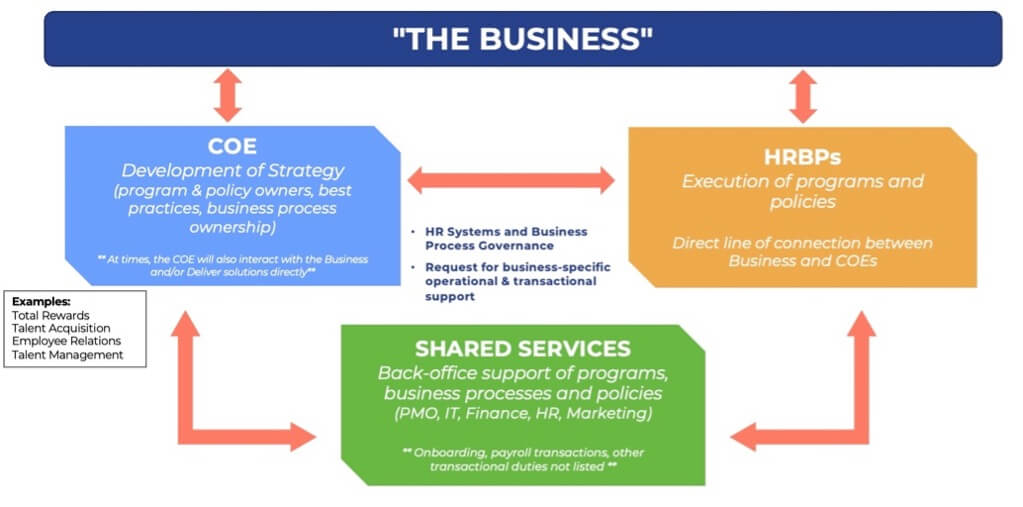Operating Model, Strategic Services
Increasing economic pressures and a desire for an elevated employee experience has organizations working to find ways to offer more services for less cost. Many organizations have increased their interest in deploying a Shared Services model, particularly for global organizations. The concept of a Shared Service model is not new, but Human Resources is just now fully embracing its potential. Several internal and external factors are driving adoption, including increased visibility for compliance and auditing requirements, cost control, role consolidation, or just a new direction from leadership.
One of the primary drivers we hear in our work with organizations is a desire to improve the employee experience. Too often, employees are unsure of where to turn when they need assistance, or they hear conflicting instructions depending on who they contact. This can result in frustration for both the employee and the company, with delays, rework, or even fines due to legal non-compliance – none of which contribute to a positive employee experience.
As Human Resources continues its quest to do more with less without compromising service, a move to Shared Services is often the best solution.
What is Shared Services?
Shared Services is an operating model in which administrative and operational duties are centralized, supporting a large proportion of the employee population. While I’m focusing primarily on the role of HR Shared Services, the model is used for several other functions, including IT, Finance, Marketing, Internal Communication, and others. Shared Services allows for increased efficiencies because it allows standardization, leveraging technology and good process design to scale work effectively.
A foundational element in a successful HR Shared Services model is clearly defined roles and responsibilities among all the players. It’s not enough to name a group a service center and hope for the best. It’s critical to identify the team structure, roles and responsibilities, as well as the work that needs to be done. Once the decision is made to move to a new operating model, the next step is to define how work flows between the Centers of Excellence (COEs), HR Business Partners (HRBPs), and Shared Services. The illustration below provides a visual overview of that relationship:

What’s important to remember is that each group works in collaboration with each other and the business. Where the power of shared services emerges is in providing that administrative support for high volume, repeatable business processes. It is the backbone of a successful business; handling the day-to-day support for employee and business requests while allowing HRBPs and COEs to work with the business on more strategic initiatives. Without Shared Services handling that important back-office support, HRBPs are bogged down with data entry, manual rework, and chasing issues. A well-designed, well-executed Shared Services operating model allows companies to consolidate skills to support the entire organization.
Considerations
When making the moved towards Shared Services, there are a number of things to take into consideration during the implementation phase – with process optimization being the most critical. I am a passionate advocate for organizations getting to know themselves before trying to change themselves. It’s vital that companies take the time to understand their current state and design their ideal future state. It’s only by having this strong point of view that companies can successfully staff and execute their Shared Services function.
Other key considerations include:
Regionalization vs Centralization: The simplest form of Shared Services is fully centralized – one service center supporting the entire organization. For more complex global organizations, a regionalized approach might make more sense. This allows for more expertise and responsiveness to local requirements; however, we would recommend that the regionalized service centers have a direct reporting line (not dotted) to the central Shared Services group.
Selecting the Right Work: Too often, Shared Services becomes the dumping ground for work nobody else wants to do – even if it makes no sense. That is not the role of Shared Services. For work to be managed in the group you must ask yourself – Is it highly repeatable? Does it support a high volume of employees? Will it save time and money? And if you’re in Shared Services, never agree to take ownership of a process until it has been optimized first.
Identify Business Process Owners for Your Governance Model: Business process owners (BPOs) are essential to Shared Services. They are a core component of a governance model that ensures process and technology enhancements stay up to date. By appointing BPOs, you identify the decision maker – that single point of contact for anything related to a process, ensuring work is tech-enabled, not tech-led. BPOs are not necessarily those who do the work but the designers of the process and often sit in the COEs, designing the strategy and requirements for a process that is carried out by others, often with the support for Shared Services. Without BPOs, processes that were once standard may become a collection of exceptions and one-off requests.
The overarching theme when contemplating a move to HR Shared Services is clear roles and responsibilities. Once everyone knows who is responsible for what, partnership and alignment can follow.
Lessons Learned
Regardless of where you are on your Shared Services journey, it’s helpful to know that others have been there before and have experienced the same successes and frustrations along the way. During the 2022 HR Technology Conference, I had the opportunity to sit down with four Global Shared Services leaders representing some well-known brands from retail and logistics. I asked them some of the lessons they’ve learned along the way, and their responses were eye-opening:
Understand what’s happening today: One organization tried to implement Shared Services without assessing their current state. As a result, they didn’t fully understand what their baseline situation was and missed out on foundational issues that needed to be rectified before fully leveraging the potential of Shared Services.
Do your homework on volume and spend: Too often, generic benchmarking is used to determine reporting structures and staffing levels. Benchmarks are an average – they don’t take into account each organization’s specific needs. A client organization suggested doing a true takt-time study to see how time is spent doing different tasks, while also leveraging ticketing data available to determine the number of resources needed within Shared Services.
Commit to a singular structure: Whether you choose centralized or regionalized, it’s important to ensure a singular vision and strategy for Shared Services. One organization thought they were allowing for regionalization but failed to put in the appropriate oversight to ensure consistency. As a result, employees were getting conflicting answers for the same questions posed to central Shared Service vs local Shared Services.
Build an accurate knowledge base: With the rush to implement the new model, an accurate knowledge base often falls to the wayside. Don’t make this mistake! A solid, accurate knowledge base serves as the foundation of Shared Services, including self-service (Tier 0), process automation, and Tier 1 support references. And don’t forget to maintain it as information changes.
Ensure you have the right skillset on the team: Simply moving HR employees into Shared Services without providing the appropriate training and support can be a disaster. One leader shared the importance of matching the work to be done with the necessary skills to be able to identify potential gaps in the team. This allowed for a more proactive approach to staffing levels and development plans, and a smoother implementation as processes were only added to Shared Services once the appropriate skills were on the team to support them.
Make it mandatory: In one organization, Shared Services is optional – business units opt in and are charged back for the support that Shared Services provides. While this might look good on paper – driving accountability for service levels, controlling spend, etc. – in practice it can harm customer service. Additionally, with internal mobility means employees may rely on Shared Services in one line of business, while having to relearn basic processes when they move to another. Other challenges are internal customers may dictate a business process, even if it causes inefficiencies for other businesses. Fully committing to Shared Services for everyone is the best way to realize all its benefits.
A unified HR team structure and operating model is designed to strengthen the relationship between COEs, Shared Services, and HR Business Partners – oh, and the business. The goal is to align policies and practices across all regions and business units to enable the implementation, execution, and administration of a better way to work. By embracing the potential of Shared Services, organizations can positively impact the employee experience.






